Published on the 10/02/2023 | Written by Heather Wright

Agile, ERP, data and integration…
The Warehouse Group says its busted digital, business and technology siloes, and reinvented itself, with an agile and data-driven approach which sees ‘customer journey teams’ as the product owners for many of TWG’s customer facing technology.
One of New Zealand’s largest retailers, The Warehouse Group (TWG) says its seen business growth and a significant boost in customer satisfaction from its ongoing transformation work.
“We have continued our shift from batch to real-time operations and execution.”
The company began a project to reinvent itself and change its business operating model, back in 2017, aiming to improve financial performance, reduce costs and generate ‘greater customer relevance’, through simplifying its systems to drive efficiencies and increase business agility.
Management consultancy firm McKinsey was called in to help in the second phase of the project, which kicked off in mid-2018 with 250 initiatives aiming to simplify everything from pricing and store operations to supplier negotiations in an effort to increase earnings from 3.6 percent to seven percent.
McKinsey says the initial work, which took only a few months, helped TWG achieve its highest annual profit in a decade, double its stock price, life its Organisational Health Index and build new capabilities for around 1,500 employees.
It also paved the way for the company to start on a new agile approach, moving away from running separate business units within each brand to run ‘more like a start-up, with small teams that delivered end-to-end results without an endless series of handoffs’.
“Becoming truly customer-centric and nimble meant TWG needed to break down existing siloes within and across brands while radically speeding up decision making and overall time to market,” McKinsey says.
“TWG reduced its 12 organisational layers down to three and redesigned itself around 18 fit-for-purpose cells [built around specific customer experiences such as work and study, recreation and celebrate] that brought people together from across functions like merchandising, planning, customer insight, marketing and supply chain.”
Breaking mindsets around standard chains of command and encouraging collaboration was a key focus.
More than 1,200 full-time employees were trained on agile to remove the siloes between brands and business units and restructure them around customer and business outcomes.
“Legacy siloes among digital, business and technology also needed to be busted,” McKinsey says. “As part of the transition, teams became product owners, which meant TWG’s mobile app, website and loyalty technology – previously managed by the technology business unit – would now be overseen by relevant customer journey teams to help align decision making with customer outcomes.”
The agile revamp is just one part of an extensive technology revamp the company has been on in recent years.
It’s currently migrating from the Oracle E-business Suite to Oracle SaaS, including ERP and EPM in what the company has said is ‘probably’ the biggest technology transformation it has undertaken.
Around $100 million was earmarked for the project in 2020, with plans to standardise on Oracle for the backend, with Salesforce’s commerce cloud for the front. The Group, which includes Noel Leeming, Torpedo 7 and The Market, were using a range of different ERP systems, including ‘home-grown’ offerings.
The new ERP finance inventory (ERPFI) system is the most significant of the core system projects, TWG chair Joan Withers said in the company’s 2022 Annual Report in July 2022.
The finance module was delivered during that financial year with the inventory module due to for delivery in April.
“Delivery of the ERPFI will result in simplifying financial processes including more timely reporting, project accounting, real-time inventory management and improved stock availability,” Withers says.
She noted too, the company’s plans to continue to invest in core systems and customer facing digital offerings, including real-time inventory management for its distribution and online fulfilment centres, and further development of its websites and apps.
“We [have] continued… our shift from batch to real-time operations and execution,” the company said in its annual report. “Real-time and relevant data is critical to so many areas of our ecosystem, from procurement, on-time supply and fulfilment, customer in-store and online shopping experience, payment capability and customer data insights through our membership program.”
A new middleware integration framework was also deployed to standardise interfacing between in systems in its ecosystem, with 127 major interfaces identified and 34 completed at the time of the report.
A new warehouse management system has also been deployed in its North Island distribution centre, with apparel sorter automation also upgraded.
“Retail is a highly competitive sector and we continue to see evidence of retail disruption every day,” the company says.
“If we fail to understand what our customers want and how they prefer to buy and receive purchases, we are compromising their willingness to come back to us.”
The impacts of the pandemic and the corresponding acceleration of eCommerce has put increased expectations on TWG’s supply chain and fulfilment capabilities ‘while inviting greater competition from a broader range of general and specialist retailers, both here and overseas’.
“This represents a considerable and ongoing material risk to our business and one we intend to combat by investing actively in our supply chain, data optimisation, improved capabilities and refreshed stores that our customers enjoy shopping in.”
Master Data Management is being extended to include Noel Leeming and supplier data, while a group order management system and accompanying automation network solutions are being deployed in FY23. A HCM solution is also due to go live enabling more responsive employee information management, project/time reporting and employee self-service.



























